Choosing vintage and antique bonsai pots involves considering size, shape, style, and color to complement the tree’s age and aesthetic. Are vintage and antique bonsai pots really worth money? Bonsai means a dwarf plant that is planted in a shallow container or tray.
Vintage or antique bonsai pots were once used for Penjing, a traditional living art, and vintage ceramic flower pots of the ancient Chinese art, before bonsai came to Japan.
Traditional living art vintage bonsai pots collections feel old, heavy, and made with real clay. That’s not just any container. It could be a Kutani ware piece from Japan or a Yixing clay pot made by Chinese folk artists.
A dwarf tree might suit a simple, bright pot, while a mature bonsai could be enhanced by a more ornate or muted one. The antique pot should harmonize with the tiny tree’s style, whether upright, cascading, or informal, and reflect its overall character.
A simple guide for collectors and growers of antique pottery brands. You might have seen a small, hand-painted pot with flowers or mountain scenes. Over time, Tokoname potters in Japan made their own styles, like Tatara or Mokko shape pots.
Some are unglazed, others are glazed, but each one tells a story. If you want to grow a bonsai or just collect these pieces, it helps to know the style, history, and material, so you can choose one that fits your miniature tree and makes it shine.
Why are Vintage Flower Pots Ceramic Antique Living Art, Looks Special?
Vintage living art with an antique pot, if you found a little tiny plant tray. It looks old. It feels heavy. Maybe the sides show hand-painted hills or trees. You wonder about ancient things. Is it just old, or is it something rare? Could this be a real antique bonsai pot?
Many vintage pots come from places like China and Japan. Some are made from Yixing clay, which feels smooth and natural. Others come from Japan’s Tokoname kilns, known for their strong, earthy style.
Some pots are painted with Kutani designs, showing peaceful scenes like rivers or mountains. These aren’t just pretty, and they tell a story. They were used in old plant arts like Penjing in China and Bonsai in Japan.
You’re here because you want to know more. Maybe you want to collect, maybe you want to grow a tree, or maybe you just like the look.
Whatever your reason, this guide will help you see what makes these pots special, how to spot real ones, and how to pick the right pot for your bonsai.
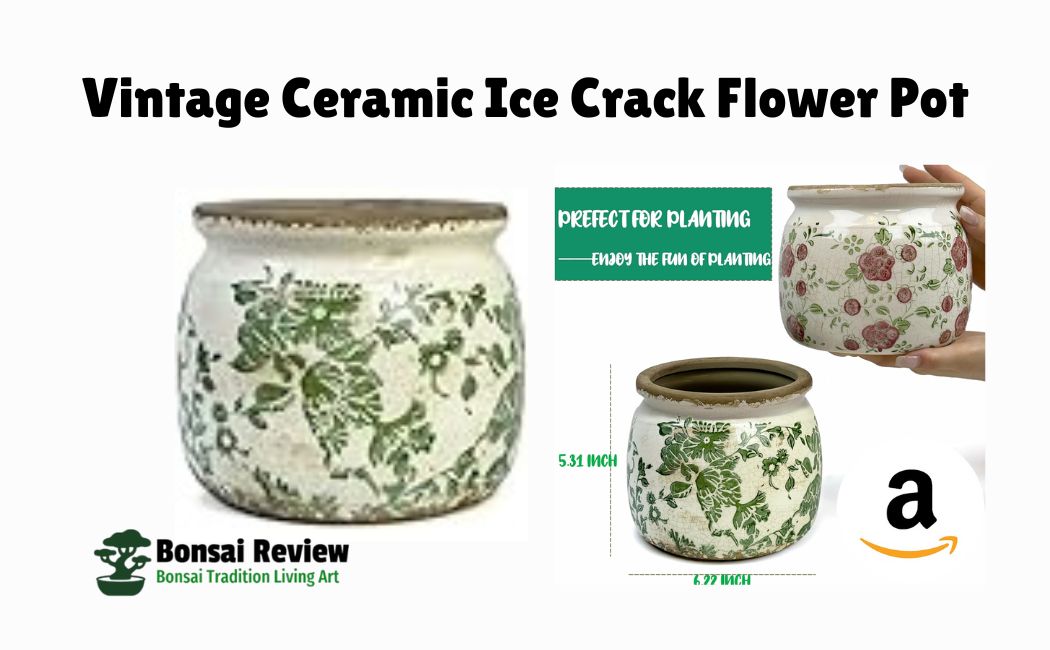
Vintage Ceramic Ice Crack Flower Pot with Drainage Holes, Country Rustic Planters for Indoor and Outdoor, Tuscan Decor, Home, Living Room, Garden Decor, Gardening Gift (Country).
| Material | Ceramic |
| Color | Green |
| Special Feature | Drainage Hole |
| Style | Country |
| Planter Form | Plant Pot |
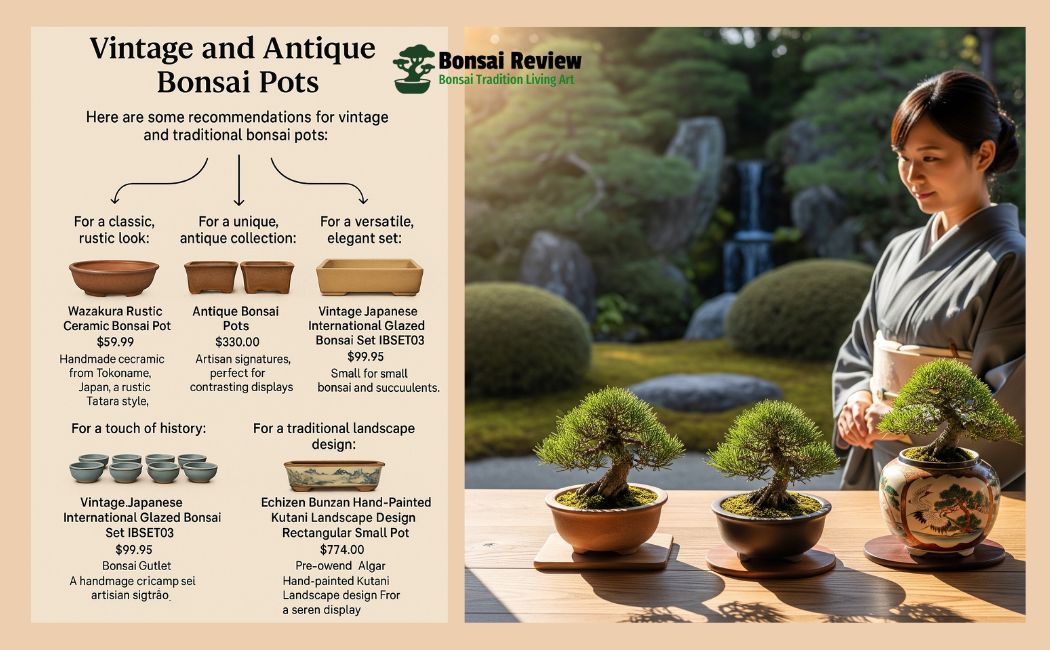
What Makes a Bonsai Pot Vintage or Antique Living Art?
A bonsai is a traditional living art form, featuring dwarf plants in pots, often accompanied by vintage flower pots, ceramic materials, and antique pottery brands. Not all old pots are antique. And not every fancy one is vintage. So, how do you tell?
Bonsai is widely recognized as a Japanese art form, and its roots can be traced to China as far back as the Han Dynasty in 210 B.C. Their earliest documented evidence of existence can be found in the tomb of Prince Zhuang Huai, who died in 706. Let’s break with vintage traditional living art bonsai pots collections:
1. What Is a Vintage Bonsai Pot?
An antique pot is called a vintage bonsai container if it’s older than 20–30 years, but not yet 100 years old. These are often handmade by skilled artists using traditional methods, like in Tokoname, Japan.
Example: The Wazakura Rustic Ceramic Pot from Tokoname has a vintage feel. It shows a rough surface, earthy color, and classic Tatara style (slab-built, not molded). It’s not ancient, but it carries tradition and skill.
More informative article: What is the Bonsai Living Art?
2. What Is an Antique Bonsai Pot?
A bonsai plant is a traditional living art, and also a vintage living art, vintage flower pots, ceramic-made, antique pottery brands
A pot is antique if it’s over 100 years old. These are rare and often come from China’s old dynasties, like the Ming or Qing, or early Japanese eras like the Edo period. They may have signs of age (cracks, fading, glaze crazing) and old maker’s marks. Unique clay-like Yixing Zisha clay, purple sand clay from Jiangsu, China.
Example: An unglazed rectangular pot made by Chinese folk artists from Yixing clay may look plain, but it’s special. It’s clay breathes well, holds roots nicely, and was used in traditional Penjing tree displays. It’s sold today as a collectible antique.
3. How to Tell the Difference Between Vintage Traditional Living Art Bonsai Pots?
| Feature | Vintage Pot | Antique Pot |
| Age | 20–99 years | 100+ years |
| Origin | Japan, Korea, China | China (Ming, Qing), early Japan |
| Marks | Sometimes | Usually |
| Value | Moderate to high | High to rare |
| Use | Still usable | Often decorative or display-only |
4. Watch for Fakes: Vintage Traditional Living Art Bonsai Pots Collections.
Some pots look old, but aren’t. They may use acid aging or fake glaze cracks to fool buyers. If a pot seems too cheap or too perfect, it might not be real. Learn to spot real clay texture, maker stamps, and wear marks underneath. If the pot has a name stamped on the bottom, look it up. You might find museum collections from Nanjing or Kyoto. These signs help prove it’s real and valuable.
- Size: The pot’s length should generally be about two-thirds the height of the tree.
- Shape: Rectangular pots often suit rugged trees, while oval or circular pots complement dainty or shallow-rooted trees.
- Style: Match the pot’s style to the dwarf tree’s style. Upright trees often look good in traditional rectangular pots, while cascading trees might be enhanced by taller, slimmer pots.
- Color: Brighter colors can convey youthfulness, while muted colors can suggest age.
- Texture: Consider the texture of the pot, and a rough texture can complement a gnarled trunk.
The Roots of Bonsai Pottery: A Quick History
To understand your bonsai pot, you need to know where it comes from. These little pots have a long, beautiful story, one that began in ancient China, grew in Japan, and now reaches homes around the world.
1. Vintage Traditional Living Art Bonsai Pots: All Started with Penjing in China.
Before the word bonsai ever existed, people in China’s Tang dynasty were already shaping small trees in shallow trays. This art was called Penjing, which means “tray scenery.” It used trees, rocks, moss, and sometimes water, like a tiny world in a pot.
Penjing pots were often:
- Made from Yixing clay
- Rectangular or oval
- Sometimes very large and heavy
- Used in temples and rich homes
2. Japan Refined the Art into Bonsai
In the Heian period, Japan introduced Penjing and gradually adapted it to its style. The style became simpler and calmer. This new art was called Bonsai, meaning “planted in a pot.” Japanese pots became:
- Smaller and cleaner in shape
- Made by hand in places like Tokoname, one of the Six Ancient Kilns
- Glazed or unglazed, with more focus on tree balance
Bonsai pots were designed to complement the tree, not just to be aesthetically pleasing. That’s when form and function truly met.
3. Other Arts Inspired the Pot Styles Too
Japan also added Saikei, a style similar to Penjing but more playful, using small trees, rocks, and sand together in one scene. These needed wider, shallow pots, often with painted or landscape scenes, similar to Kutani ware.
4. Modern Bonsai Pottery Today
Now, modern potters across the world continue this tradition:
- In the U.S., potters like Arthur Joura design American-style bonsai pots
- Collectors find vintage pots from eBay, Etsy, or shops like Wazakura Japan
- Many new pots copy the look of old ones, but knowing the history helps you tell which ones are real
5. Simple Takeaway: Vintage Traditional Living Art Bonsai Pots Collections.
Your bonsai pot is not just a container, and it’s part of a deep story that began with Penjing in China. Cultivating bonsai is as much about nurturing our patience as it is about observation.
Additional Tips: Vintage Traditional Living Art Bonsai Pots Collections.
- Aesthetics: Ultimately, the pot should complement the tree’s aesthetics and enhance its overall beauty.
- Health: The pot should also be appropriate for the tree’s root system and ensure good drainage.
- Trial and Error: When repotting, try different pots with the tree to see how they look before making a final decision.
These two principles are essential for the survival and thriving of these miniature trees, ensuring they develop beautifully over time. Grew with Bonsai in Japan, and lives on in every pot collector’s shelf today.
What Are the Meanings of Vintage Traditional Living Art Bonsai Pots, Collections, Styles, and Shapes?
When selecting a bonsai pot, you don’t just consider color or size. The shape and style reveal a great deal about the pot’s origin, purpose, and harmony with the tree. Here’s how to understand what your pot is saying.
1. Pot Shapes and Their Meanings:
| Shape | Best For Tree Style | Common Origin | Style Meaning / History |
| Rectangular | Formal upright, root-over-rock | China, Tokoname (Japan) | Strong, solid, traditional. Common in antique Yixing pots. |
| Oval | Informal upright, forest style | Tokoname, Shigaraki | Soft and gentle. Balances curves of tree trunks. |
| Round | Literati, small flowering trees | Kutani, modern pottery | Elegant, calm. Often glazed and decorative. |
| Mokko (Kidney) | Cascade, semi-cascade | Kutani, Echizen | Flowing shape mirrors nature. Traditional Japanese style. |
| Tatara (Slab-built) | Informal, rustic trees | Tokoname Rustic Ware | Handmade feel. Rough and earthy. Seen in vintage pots. |
| Drum | Powerful root base trees | Chinese Penjing pots | Bold, heavy look. Shows age and strength. |
Being aware of common forgeries is an excellent tip for gauging the authenticity of antiques. In particular, identify material variability, such as mismatched wood grains in furniture or unexpected seams in pottery. A genuine piece should demonstrate craftsmanship consistent with the era from which it claims its origin.
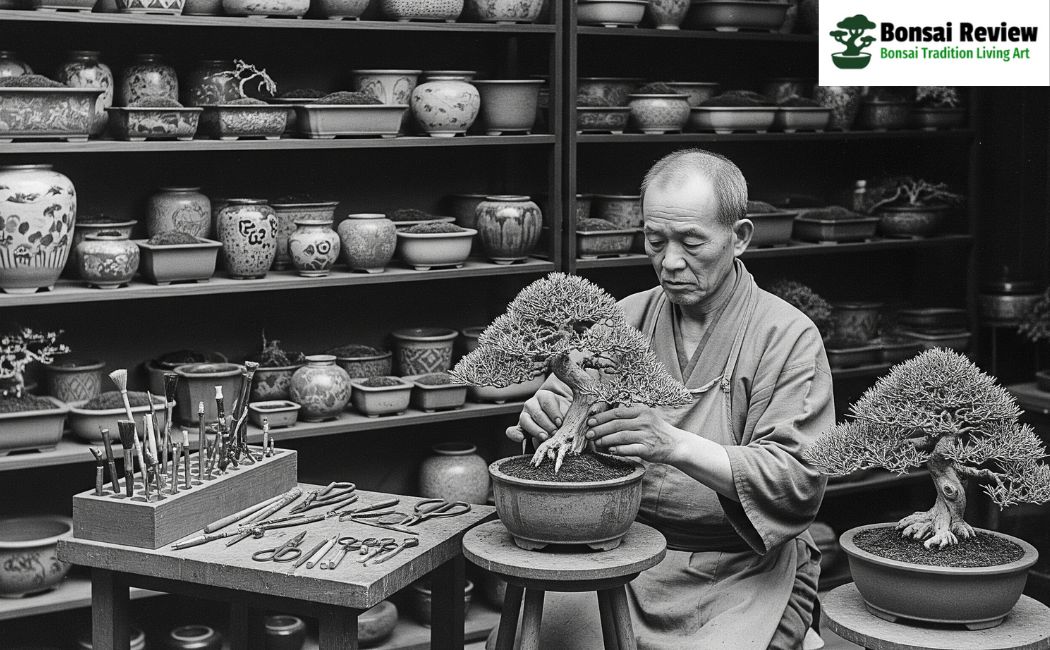
2. Pot Design Motifs and Glazing Styles
| Design Style | Used In | Visual Feel | Notes |
| Unglazed | Pines, Junipers | Natural, earthy | Common in antique Chinese and Tokoname pots |
| Glazed (solid color) | Flowering trees | Soft, colorful | Brings visual balance with the tree’s foliage |
| Hand-painted (Kutani) | Maples, Saikei displays | Scenic, artistic | Seen in Echizen Bunzan and Kutani pots |
| Crackle-glazed | Indoor displays | Aged, antique look | Found in vintage Japanese and replica Chinese pots |
| Rustic / Textured | Informal styles | Raw, handmade feel | Used in Tatara slab pots from Tokoname |
3. Example of Vintage Traditional Living Art Bonsai Pots Collections:
- A Mokko-shaped pot with a Kutani landscape painting is perfect for a peaceful cascade bonsai on display.
- A rectangular, unglazed Yixing pot fits a formal upright pine, letting the tree show its power.
- A Tatara-style rustic pot adds charm to a natural-looking juniper or forest bonsai.
Simple Tip: The pot should match the mood of your tree. If your tree is wild and flowing, pick a soft or round pot. If your tree is strong and upright, choose a bold rectangle or drum shape. Don’t just choose by looks, choose by story.
Glazed vs. Unglazed: What’s the Difference?
When you look at bonsai pots, you’ll notice two main types: glazed and unglazed. Each one does more than just change how the pot looks, and it also affects how your tree grows and how the full display feels. Let’s keep it simple:
What it is Unglazed Pots?
- Clay with no shiny coating
- Feels rough or dry
- Usually brown, beige, red, or gray
Best for vintage traditional living art bonsai pots collections with Pines tree, juniper plant pots are strong trees, and styles like formal upright, windswept, or rock planting.
Why use vintage traditional living art bonsai pots?
- Feels natural
- Matches trees with rough bark or sharp lines
- Helps water breathe through the pot (more air to roots)
Real Example: That Yixing Beige Rectangular Pot made by Chinese artists? It’s unglazed. Perfect for a powerful pine or a twisted juniper.
What it is Glazed Pots?
- Clay was covered in a smooth, colorful coat
- Can be shiny, crackled, or painted
Best for: Flowering trees (like azalea), Maples, cherry, and softer trees with delicate shapes or bright leaves
Why use it:
- Adds color and charm
- Protects the clay
- Makes a display feel softer, brighter
Real Example: The Kutani Landscape Pot from Echizen Bunzan? It’s glazed, hand-painted, and looks like art. Great for a maple in full red leaves.
Side-by-Side Comparison:
| Feature | Unglazed | Glazed |
| Surface feel | Rough, matte | Smooth, glossy, or shiny |
| Best for | Pines, junipers, conifers | Maples, flowers, soft trees |
| Clay breathability | Higher (more airflow) | Lower (holds more water) |
| Style match | Rustic, strong, aged trees | Elegant, colorful, light trees |
| Look & feel | Natural, raw, earthy | Decorative, clean, polished |
What Should You Pick?
Think about your tree’s personality: Vintage and antique bonsai pots are worth money.
- Strong and sharp? Go unglazed
- Soft and gentle? Try glazed
- Want something with a story? Look for glazed vintage with painting or unglazed antique with kiln marks
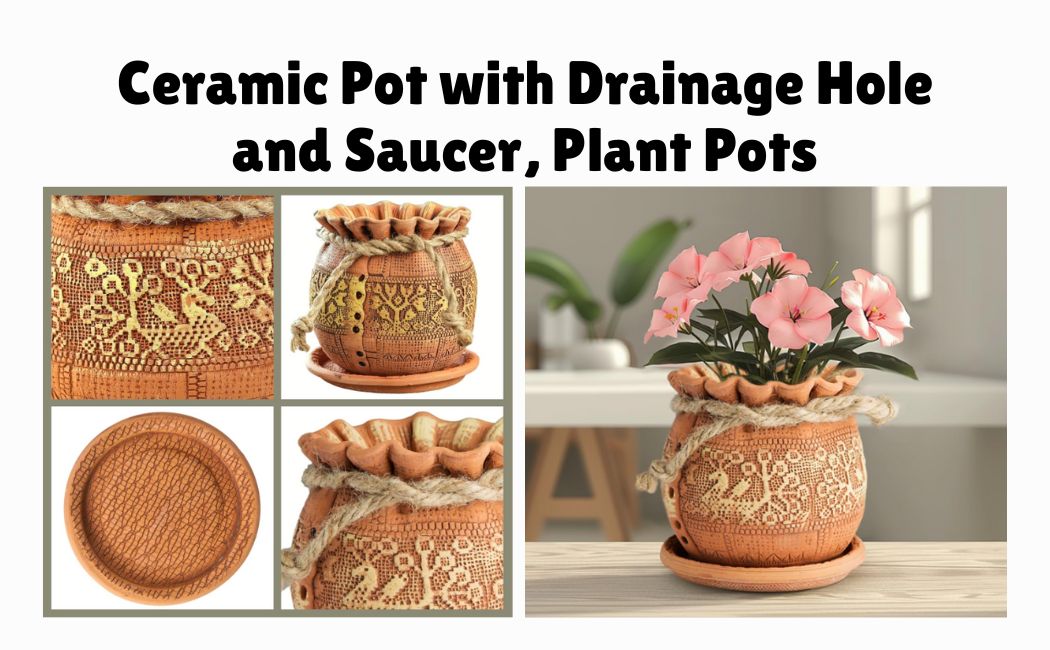
Ceramic Pot with Drainage Hole and Saucer, Plant Pots, Modern Decorative Planters for House Plants, Indoor Flower Plants, Cute Flower Pot, and Handmade Gifts with Bonsai Review.
| Material | Ceramic |
| Color | Birds (1.7 L) |
| Special Feature | Drainage Hole |
| Style | Handmade |
| Planter Form | Plant Pot |
How to Spot a Real Antique Bonsai Pot?
Not every old-looking pot is antique. Some are just made to look old. So, how do you know what’s real? Here’s a simple way to check if your bonsai pot is a true antique over 100 years old, made by hand, and full of history.
1. Look for Maker’s Marks or Stamps
Old pots often have a small mark or stamp on the bottom. This could be:
- A potter’s signature
- A kiln seal (like from Tokoname or Yixing)
- Symbol or Chinese character
These marks help you trace where the pot came from and who made it.
Real Example: A Yixing pot from China might have a square red stamp. That’s the artist’s seal. Some pots also have double stamps, one for the potter and one for the studio.
2. Check the Clay and Texture, and the Real antique pots feel:
- Heavy for their size
- Slightly uneven or handmade
- Natural and aged (not shiny-perfect)
The clay might show tiny holes, glaze cracks, or a dry finish. If the pot feels too perfect or machine-made, it might be a modern copy.
Tip: Antique pots often use Tokoname clay (Japan) or Yixing clay (China), both are strong, earthy, and rare.
3. Look for Crazing and Patina
Crazing means tiny lines in the glaze. It happens as pots age and cool over time.
Patina is a soft, worn look from years of use, water stains, soil marks, or faded paint.
Warning: Some fakes copy this by adding fake cracks or soaking the pot in acid. But they look forced. Real crazing is gentle and natural.
4. Compare with Known Museum Pieces
Look at trusted sites:
- JapaneseBonsaiPots.net
- Bonsai Penjing Museum Collection
- Nanjing Museum’s antique pot displays
Compare your pot’s shape, clay, and bottom stamp. If it looks similar, it might be the real thing.
5. Signs It Might Be a Fake;
| Fake Sign | What It Means |
| Pot is too lightweight | Likely modern material |
| No stamp or unclear marks | Could be mass-produced |
| Glaze looks “too perfect.” | Possibly machine-made or artificially aged |
| The price is too low to be real | Be careful, real antiques cost more |
Quick Tip: If you’re not sure, take clear photos and post them in bonsai forums or share with experts like Curator Arthur Joura or collectors on sites like Curator’s Journal and Bonsai Empire.
Key Considerations: Vintage Living Art Antique Pottery Brands Impacts.
When considering antique pottery brands, key factors include maker’s marks, condition, rarity, and artistic merit. Popular vintage pot brands like Moorcroft, Rookwood, Roseville, and Wedgwood are often sought after by collectors, but pieces don’t need to be from these makers to be valuable. Understanding the variation of each brand, including their signature styles and production periods, can help in identifying and valuing antique pottery. Key Considerations for Antique Pottery Brands:
- Maker’s Mark: The presence of a maker’s mark is crucial for identification and can significantly impact value.
- Condition: Items in excellent condition generally fetch higher prices.
- Rarity: Rare or limited-edition pieces are highly sought after by collectors.
- Artistic Merit: The aesthetic appeal and artistic style of a piece can also influence its value.
- Provenance: Documented history of ownership can add to a piece’s value.
- Popularity: Certain styles and makers fluctuate in popularity, so understanding trends is important.
- Authenticity: Ensuring the piece is genuine is crucial, as forgeries exist.
Examples of Notable Antique Pottery Brands:
- Moorcroft: Known for its vibrant Art Nouveau designs and high-quality glazes.
- Rookwood: Famous for its distinctive glazes and Arts and Crafts movement designs.
- Roseville: Recognizable for its nature-inspired patterns and Art Pottery aesthetic.
- Wedgwood: A historic brand with a wide range of designs and a long-standing reputation.
Additional Tips for Identifying Antique Pottery: Are Vintage and antique bonsai pots really worth money?
- Observe markings: Look for maker’s marks, dates, and other distinguishing features.
- Examine glazes: Pay attention to the type of glaze used, as this can indicate age and origin.
- Study the clay: Older pottery often uses genuine clay, while modern pieces may use alternatives.
- Note the shape and design: Certain shapes and design styles are characteristic of specific periods and makers.
- Consult with experts: If you are unsure about a piece, seek advice from a reputable antique dealer or appraiser.
Antique bonsai pots, primarily from China and Japan, are highly valued for their craftsmanship, age, and connection to the history of bonsai. Vintage and antique bonsai pots are worth money, and handmade American Bonsai pots
They are often made from high-quality clay, with intricate designs and glazes, and can be quite rare and expensive.
The most sought-after pots are those from specific regions and eras, such as the Yixing region in China or those made before 1868 in Japan.
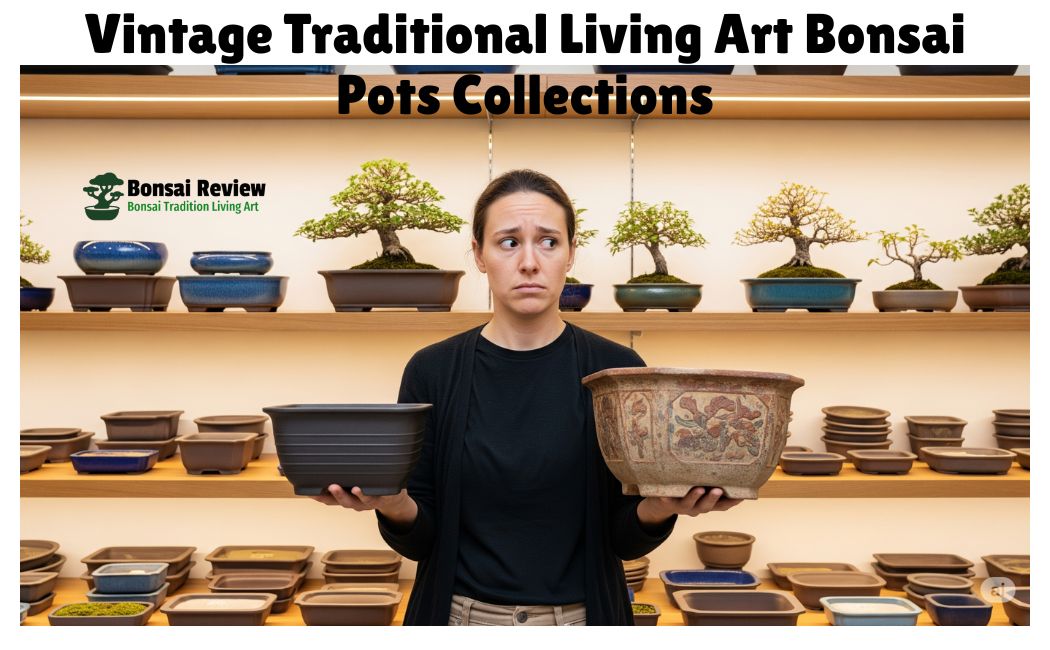
Top Vintage Bonsai Pot Picks: Side-by-Side Comparison Guide.
Looking for a vintage or antique bonsai pot? Here’s a quick guide to help you choose the best one for your tree, taste, and budget. These pots aren’t just containers; they’re part of your tree’s story.
| Product | Style | Material | Size | Best For | Where to Buy |
| Wazakura Rustic Ceramic Pot | Rustic Tatara | Handmade ceramic (Tokoname, Japan) | 6.3″ diameter | Simple, earthy bonsai displays | Wazakura Japan |
| Antique Chinese Pot Pair | Antique / Artisan | Unknown clay, signed | Varies | Display pieces, contrast setups | eBay (pre-owned) |
| International Glazed Set (IBSET03) | Vintage Glazed | Glazed ceramic | 3.5″ each | Small bonsai, succulents | Bonsai Outlet |
| Yixing Beige Clay Pot | Traditional Chinese | Unglazed Yixing clay | 12″ rectangular | Classic bonsai training and display | Amazon |
| Kutani Landscape Pot (Echizen Bunzan) | Mokko, Painted Kutani | Kutani ware, hand-painted | Small | Saikei, or peaceful scenic trees | Etsy (AbiAntique) |
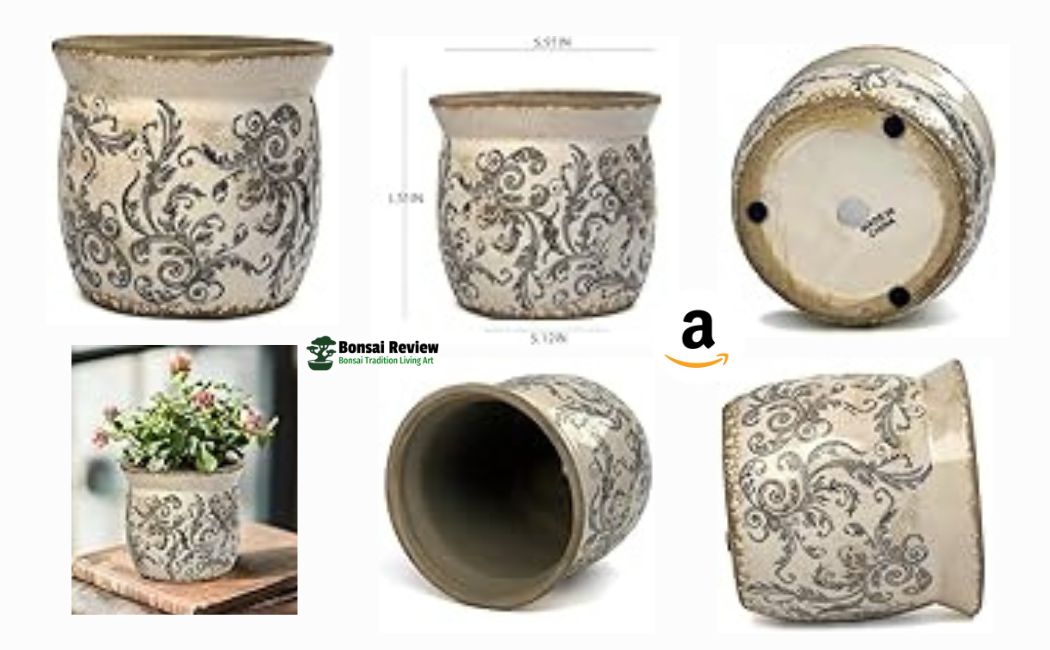
Vintage Grey Ice Crack Ceramic Planter with Drainage, 5.51 Inch Rustic Flower Pot for Indoor Outdoor, Farmhouse Decor, Gardening Gift for your Beloved!
| Material | Ceramic |
| Color | White and Blue |
| Special Feature | Drainage Hole |
| Style | Traditional Chinese |
| Planter Form | Plant Pot |
How to Choose Vintage Traditional Living Art Bonsai Pots Collections?
Here’s what to think about: Most valuable vintage and antique bonsai pots:
- Want a natural look? Go with Wazakura’s handmade rustic pot.
- Looking for real history? Try the antique Chinese pair with artisan stamps.
- Like colorful designs? The hand-painted Kutani pot adds flair.
- Need a full set? The 8-piece glazed set works great for variety.
- Going traditional? The Yixing clay pot offers classic style and breathability.
The older the pot, the more character it holds. But don’t just chase age, make sure the style matches your tree and your care needs. A pot that’s too big or shallow can harm your bonsai.
Now you’ve got a list to shop from and the info to shop smart.
Tips to Care for Vintage and Antique Bonsai Pots
Vintage and antique bonsai pots are more than just containers, and they’re pieces of art and history. Taking good care of them helps you keep their beauty and value for years.
1. Handle with Care: Most valuable vintage and antique bonsai pots.
- Always lift pots by the base, not by the rim or sides.
- Avoid dropping or bumping them on hard surfaces.
- When moving a heavy pot like a Yixing clay one, use two hands.
2. Clean Gently: Bonsai pots handmade value for vintage American Bonsai pots.
- Use a soft brush or cloth to remove dust.
- Wash pots with warm water only, no harsh soaps or chemicals.
- If you need to remove mineral buildup, soak the pot in a mix of water and a little white vinegar for a few minutes, then rinse well.
3. Protect from Extreme Weather;
- Avoid leaving antique pots outside in freezing temperatures; water inside can freeze and crack the clay.
- In summer, avoid direct scorching sunlight for long hours, which can dry out and weaken the clay.
- If you live in a cold climate, bring delicate pots indoors or cover them during winter.
4. Check Drainage Holes;
- Make sure drainage holes are clear to prevent water buildup.
- Gently remove any debris with a toothpick or soft brush.
- Good drainage protects both your bonsai roots and the pot itself.
5. Avoid Repairs That Hurt Value;
- Don’t glue or paint cracks to “fix” the pot without expert advice.
- Some collectors prefer original wear and natural aging.
- If serious repairs are needed, consult a professional restorer.
6. Use Proper Soil and Planting Techniques;
- Use soil that drains well but holds moisture.
- Avoid planting heavy or fast-growing trees in delicate vintage pots.
- Balance tree size with pot size to avoid stress on the pot’s structure.
Vintage pots tell a story through their marks, chips, and colors. Care for them like a treasure, and they’ll keep adding charm to your bonsai for decades.
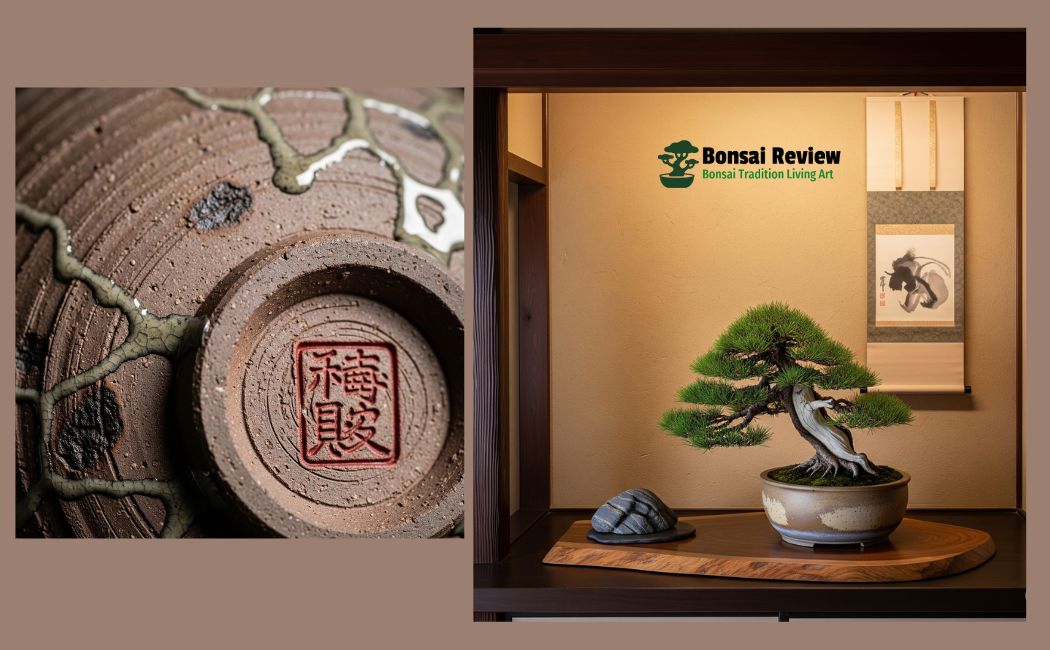
How to Identify Rare Antique Bonsai Pots?
Check the Maker’s Mark (Kiln Stamp) for look underneath the pot for marks from famous kilns like:
- Tokoname (Japan)
- Yixing (China)
- Echizen (Japan)
These show the pot’s origin and can prove its age and authenticity.
- Look for Signs of Age: Rare vintage and antique bonsai pots
- Glaze crazing (fine cracks in the surface)
- Soft, worn edges
- Uneven texture or natural discoloration
These suggest it was made and aged naturally over time, not mass-produced.
Identify Famous Potters: Vintage and antique bonsai pots value
- Names like Ino Shukuho, Yamaaki, or Ryukizaemon add value and rarity.
- Artisan signatures may be engraved or painted under the pot.
Observe the Shape and Design: Most valuable vintage and antique bonsai pots.
- Rare pots often use shapes like Mokko (kidney), oval, or rectangular with flared corners.
- They follow the bonsai balance rule, matching the pot’s form with the tree’s style.
Study the Clay Material and Color:
- Yixing clay is usually beige, red, or purple and has a fine texture.
- Tokoname pots are often dark red or brown and unglazed.
- Genuine antique clay feels heavier and breathes better than modern copies.
Compare with Museum Pieces:
- Use trusted examples from the Nanjing Museum or Japanese Bonsai Pots.net archives.
- Look for similar features in your pot’s form, color, and markings.
Watch Out for Fakes:
- Rare vintage and antique bonsai pots
- Many replicas exist online.
- Buy only from trusted sellers like Wazakura Japan, Bonsai Outlet, or antique dealers with bonsai knowledge.
Be careful, many fakes exist, and always check with an expert or reference trusted resources like Japanese Bonsai Pots or Bonsai Empire before buying.
Conclusion: The Right Vintage Pot Tells Your Bonsai’s Story
Choosing a vintage or antique bonsai pot is more than just picking a container. The most valuable vintage and antique bonsai pots are about connecting with history, art, and nature all at once.
If you choose a rough Tokoname Tatara pot, a smooth Yixing clay antique, or a colorful Kutani hand-painted piece, the right pot will bring out the best in your bonsai tree.
Look for real maker’s marks, match the pot’s style and size to your tree, and care for your pot gently. With the right choice, the most valuable vintage and antique bonsai pots, your bonsai will not only grow strong but also tell a beautiful story, a story that spans centuries and cultures.
So, take your time. Handmade American Bonsai pots, and Rare vintage and antique bonsai pots
Explore the world of vintage bonsai pots. And find the perfect pot that speaks to you and your unique bonsai tree.
Excellent article about: Artificial Money Plant Vastu: Pros & Cons Tips for Your Home.
Vintage and antique bonsai pots are worth money. Happy bonsai journey with Bonsai Review!
FAQs: Rare Vintage and Antique Bonsai Pots.
1. What is a bonsai pot called?
Japanese (Tokoname) Pots. Tokoname ware (常滑焼, Tokoname-yaki) is a type of Japanese pottery, stoneware, and ceramics produced in and around the municipality of Tokoname, Aichi, in central Japan. Tokoname was the location of one of the Six Ancient Kilns of Japan.
2. What is a nanban bonsai pot?
All of them are collectively referred to as Nanban. The earliest Nanban containers entered the bonsai scene before the Meiji period and were typically small, round, trough-shaped pots, dishes, and jar lids, which were modified into a bonsai pot by drilling holes in their bottom.
3. How can I tell if a bonsai pot is really antique?
Look for maker’s marks or stamps on the bottom, signs of natural aging like glaze crazing, and feel the clay’s texture. Compare with trusted museum examples or bonsai expert sites.
4. What is the difference between vintage and antique bonsai pots?
Vintage pots are usually 20 to 99 years old. Antique pots are over 100 years old and are often rarer and more valuable.
5. Should I use glazed or unglazed pots for my bonsai?
Use unglazed pots for strong trees like pines or junipers because they let air reach the roots. Use glazed pots for flowering or soft-leaf trees like maples for a colorful display.
6. Can I use antique pots to grow bonsai trees?
Yes, but be careful. Some antique pots are fragile or decorative only. Make sure drainage holes are clear and the pot matches your bonsai tree size.
7. How do I care for vintage bonsai pots?
Antique pots handle with care, clean gently with water, protect from extreme weather, and avoid harsh chemicals or repairs without expert help.
8. Where can I buy authentic vintage bonsai pots?
Trusted sources include Wazakura Japan, Bonsai Outlet, Etsy (AbiAntique), and well-reviewed eBay sellers. Always check reviews and ask for details.
9. What are the three major types of pottery?
Pottery is traditionally divided into three types: earthenware, stoneware, and porcelain. All three may be glazed and unglazed. All bonsai pots may also be decorated by various techniques.
10. Why are bonsai pots blue?
Blue is a colour that naturally complements the earthy tones of the bonsai soil and the greens and browns of the tree. Rare vintage and antique bonsai pots with harmonious colour pairing create a pleasing and balanced appearance.